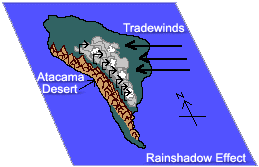
 |
||
Home > Weather > Driest Desert Driest Place: Atacama Desert, Chile Even the Driest Place on Earth has Water Salt Lakes
Snow In the higher elevations when precipitation comes to Atacama snow falls instead of rain. There are small patches of unmelted snow in the mountain tops where in never gets warm enough to melt the snow. Underground Anywhere you go in the world, regardless of how much or little it rains, there is always water underground. After it rains, some of the rainwater evaporates back into the air, but much of it trickles down into the ground and stays there - even in the desert. How much water and where depends on a number of things; soil composition, air and soil surface temperature, amount and frequency of rainfall/precipitation, and drainage. Since the Andes is a volcanically active mountain range, the magma beneath the ground will heat the groundwater in certain places causing geysers to erupt. Fog and Dew
Most of the precipitation that comes to the Atacama is in the form of fog that blows in the from the Pacific. Fog is essentially very low clouds, consisting of water vapor cooling and beginning to condense. If you've ever been in fog you know that it can leave you a little moist. When the air temperature reaches dew point the water vapor in the air condenses to leave little droplets of water behind. The few things that are able to survive in the Atacama live on the combined moisture from fog and dew. Does Anything Live There? Many people have the view that deserts are places forsaken by Mother Nature and that no living thing would possibly want to set up camp in a place so dry. Although it is tough to find anything living in the Atacama there are isolated pockets and small patches of plants, which support life for animals and insects. Some plant species have adapted well to this dry environment by developing tap roots that run very deep into the ground gathering water from below. There are flocks of flamingos that live in and around the salt lakes feeding on red algae that grows in the waters. There are even people living in the Atacama. There is a town called Calama in the desert which is complete with motels, restaurants and shops, but it is definitely not the norm. For the most part, Atacama is a pretty lonely place. Humans have lived in the Atacama for many thousands of years, based on the cultural relics and artifacts that archaeologists have found. The South American Indians who have set up housekeeping in the desert over the millennia have left relics from their culture and even themselves. Because the Atacama is so bone-dry the bodies of the buried indians have dried perfectly preserved turning them into mummies. Some of the oldest mummies found anywhere on earth have come from the Atacama Desert and have been dated to be 9,000 years old! What Causes Deserts? One reason is that the high atmospheric pressure in this region over the Andes can cause dry, cold air from the upper altitudes to compress and come down to earth. This dry air has almost no water vapor so it can be easily heated by the sun, causing high ground temperatures with very low humidity. 
Another reason that the Atacama doesn't get enough rainfall is because of a phenomenon called rainshadow. The warm, moist tropical air that blows on the tradewinds from the east, which douse the South American rainforest, get hung-up on the east side of the Andes. The mountains are so high in altitude that the air cools, condenses and rains (or snows) on the mountains. As the air descends the other side of the mountain range it warms, holding in its moisture preventing rain from falling on to the ground below. This is one of the reasons why the Amazon basin and river are the largest anywhere in the world. The mountains that cause the Amazon to be the largest river from collecting all the rainfall are also responsible for preventing the Atacama from ever receiving any rainfall. The driest and one of the wettest places in the world are right next to each other! |
Get Your Degree!Find schools and get information on the program that’s right for you. Powered by Campus Explorer
|
Copyright © 1998-2015. |